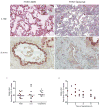Severe pandemic 2009 H1N1 influenza disease due to pathogenic immune complexes
- PMID: 21131958
- PMCID: PMC3034774
- DOI: 10.1038/nm.2262
Severe pandemic 2009 H1N1 influenza disease due to pathogenic immune complexes
Abstract
Pandemic influenza viruses often cause severe disease in middle-aged adults without preexisting comorbidities. The mechanism of illness associated with severe disease in this age group is not well understood. Here we find preexisting serum antibodies that cross-react with, but do not protect against, 2009 H1N1 influenza virus in middle-aged adults. Nonprotective antibody is associated with immune complex-mediated disease after infection. We detected high titers of serum antibody of low avidity for H1-2009 antigen, and low-avidity pulmonary immune complexes against the same protein, in severely ill individuals. Moreover, C4d deposition--a marker of complement activation mediated by immune complexes--was present in lung sections of fatal cases. Archived lung sections from middle-aged adults with confirmed fatal influenza 1957 H2N2 infection revealed a similar mechanism of illness. These observations provide a previously unknown biological mechanism for the unusual age distribution of severe cases during influenza pandemics.
Figures




Similar articles
-
Serum strain-specific or cross-reactive neuraminidase inhibiting antibodies against pandemic А/California/07/2009(H1N1) influenza in healthy volunteers.BMC Res Notes. 2015 Apr 10;8:136. doi: 10.1186/s13104-015-1086-z. BMC Res Notes. 2015. PMID: 25889924 Free PMC article.
-
High titer and avidity of nonneutralizing antibodies against influenza vaccine antigen are associated with severe influenza.Clin Vaccine Immunol. 2012 Jul;19(7):1012-8. doi: 10.1128/CVI.00081-12. Epub 2012 May 9. Clin Vaccine Immunol. 2012. PMID: 22573737 Free PMC article.
-
Cytokine and chemokine profiles in lung tissues from fatal cases of 2009 pandemic influenza A (H1N1): role of the host immune response in pathogenesis.Am J Pathol. 2013 Oct;183(4):1258-1268. doi: 10.1016/j.ajpath.2013.06.023. Epub 2013 Aug 11. Am J Pathol. 2013. PMID: 23938324 Free PMC article.
-
Cross-reactive immunity against influenza viruses in children and adults following 2009 pandemic H1N1 infection.Antiviral Res. 2015 Feb;114:106-12. doi: 10.1016/j.antiviral.2014.12.008. Epub 2014 Dec 13. Antiviral Res. 2015. PMID: 25513756
-
Assessment of baseline age-specific antibody prevalence and incidence of infection to novel influenza A/H1N1 2009.Health Technol Assess. 2010 Dec;14(55):115-92. doi: 10.3310/hta14550-03. Health Technol Assess. 2010. PMID: 21208549
Cited by
-
Antibody-Dependent Cell-Mediated Cytotoxicity to Hemagglutinin of Influenza A Viruses After Influenza Vaccination in Humans.Open Forum Infect Dis. 2016 May 18;3(2):ofw102. doi: 10.1093/ofid/ofw102. eCollection 2016 Apr. Open Forum Infect Dis. 2016. PMID: 27419174 Free PMC article.
-
Vaccine-Associated Enhanced Respiratory Disease following Influenza Virus Infection in Ferrets Recapitulates the Model in Pigs.J Virol. 2022 Mar 9;96(5):e0172521. doi: 10.1128/JVI.01725-21. Epub 2022 Jan 5. J Virol. 2022. PMID: 34985999 Free PMC article.
-
Heterologous prime-boost H1N1 vaccination exacerbates disease following challenge with a mismatched H1N2 influenza virus in the swine model.Front Immunol. 2023 Oct 20;14:1253626. doi: 10.3389/fimmu.2023.1253626. eCollection 2023. Front Immunol. 2023. PMID: 37928521 Free PMC article.
-
Study of Antibody-Dependent Reactions of Mast Cells In Vitro and in a Model of Severe Influenza Infection in Mice.Front Immunol. 2021 Jul 14;12:689436. doi: 10.3389/fimmu.2021.689436. eCollection 2021. Front Immunol. 2021. PMID: 34335593 Free PMC article.
-
Galectins regulate the inflammatory response in airway epithelial cells exposed to microbial neuraminidase by modulating the expression of SOCS1 and RIG1.Mol Immunol. 2015 Dec;68(2 Pt A):194-202. doi: 10.1016/j.molimm.2015.08.005. Epub 2015 Sep 6. Mol Immunol. 2015. PMID: 26355912 Free PMC article.
References
-
- Tumpey TM, et al. Characterization of the Reconstructed 1918 Spanish Influenza Pandemic Virus. Science. 2005;310:77–80. - PubMed
-
- Kobasa D, et al. Aberrant innate immune response in lethal infection of macaques with the 1918 influenza virus. Nature. 2007;445:319–323. - PubMed
-
- Geiss GK, et al. Cellular transcriptional profiling in influenza A virus-infected lung epithelial cells: the role of the nonstructural NS1 protein in the evasion of the host innate defense and its potential contribution to pandemic influenza. Proc Natl Acad Sci USA. 2002;99:10736–10741. - PMC - PubMed
Publication types
MeSH terms
Substances
Grants and funding
LinkOut - more resources
Full Text Sources
Other Literature Sources
Medical
Molecular Biology Databases

